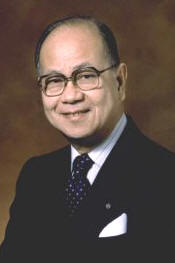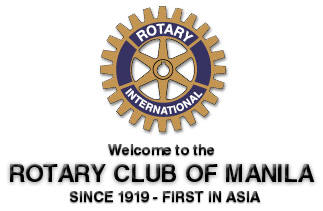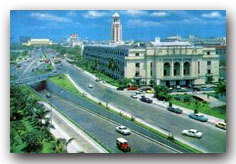 |
| HOME | GLOBAL | DISTRICTS | CLUBS | MISSING HISTORIES | PAUL HARRIS | PEACE |
| PRESIDENTS | CONVENTIONS | POST YOUR HISTORY | WOMEN | FOUNDATION | COMMENTS | PHILOSOPHY |
| SEARCH | SUBSCRIPTIONS | JOIN RGHF | EXPLORE RGHF | RGHF QUIZ | RGHF MISSION | |
|
Rotary Club of Manila Charter 478 1 June 1919 Rotary International District 3810 Home Club of Rotary International President M.A.T. Caparas 1986-87 |
|
Rotary was almost fourteen years old when Leon J. Lambert, then one of the leading businessmen of Manila and president of Lambert Sales Co., inspired by what he had heard of Rotary, started to correspond with President John Poole of the International Association of Rotary Clubs, now known as Rotary International. As a result, on January 12, 1919, Lambert entertained Rotarian Roger D. Pinneo, a member of the Rotary Club of Seattle who had been sent to Manila with a commission to assist in the organization of Rotary Clubs in the Far East, at a luncheon in his home in Pasay with Messrs. E. E. Elser, James Geary, A. W. Beam and F. N. Berry, prominent businessmen of Manila. The five constituted themselves into a committee to proceed with the preliminary steps incident to the organization of a Rotary club. Lambert was elected as chairman, and Berry as secretary of this committee. Informal meetings were held on January 14, 16, and 24, before the organization of the new club was completed with 38 charter members, two of whom were Filipinos (Gabriel Lao and Gregorio Nieva, one was Chinese (Alfonso SyCip), and the rest Americans.
A provisional board of directors was formed and served until June 1919, when
the first annual meeting was held. Elected as the first
LEON J. LAMBERT, President Before the end of January 1919, a cablegram was sent to the International Association of Rotary Clubs in Chicago, advising it of the formal organization of the Rotary Club of Manila (RCM), the first club in Asia, with a membership of 38. The first office of the RCM was located in the office of the Benguet Consolidated Mining Co. at Kneedler Building, where further meetings were held and additional members elected. The Charter No. 478 was not granted however until June 1, 1919. The first regular weekly meeting was held on Wednesday, January 29, 1919 at the Manila Hotel. At the second luncheon meeting it was decided to change the weekly meeting days from Wednesday to Thursday, and this has remained in effect since that time. The Manila Hotel continued to be the meeting venue until 1971, when the Manila Hilton became the new meeting place. In July 1984, the club returned to Manila Hotel. From 1919 to 1935, RCM was under the direct supervision of the International Association of Rotary Clubs. RCM organized its first daughter club, the Rotary Club of Cebu, in 1932, followed by the Rotary Club of Iloilo in 1933. Both were also under the direct supervision of the International Association of Rotary Clubs. In 1935, these three clubs were included in the district of China up to 1938, when the Philippine District No. 81 (changed to District 48, then to District 385, and now to Districts 379, 380, 382, 385, 386 and 387) was created. Two years later RCM organized the Rotary Clubs of Bacolod and Baguio. In 1939, through the initiative of then R.I. Vice President Carlos P. "Romy" Romulo, the Rotary Club of Guam, was organized as RCM's first overseas daughter club. During World War II all the clubs in the Philippines ceased to function. The last meeting of RCM was held on the island of Corregidor on May 6, 1942, to induct Gen. Douglas MacArthur as honorary member. However, some Manila Rotarians occasionally met in groups, whenever possible. The club was formally reorganized on September 13, 1945, with Gil J. Puyat reassuming the club presidency. The Rotary Club of Manila, being the premier service club of its kind in Asia, has had an outstanding record of leadership in service to the community. In its 79-year history, it has pioneered various projects covering the whole spectrum of the four avenues of Rotary service. Most of these have become self-administered and institutionalized as years went by, thus leaving RCM to freely and continuously give birth to new ideas and solutions to the needs and problems of the community, applying these plans into concrete projects, bringing these to maturity and independence, and then going on to discover other new worlds of service. |
 Rotary/
Rotary/
